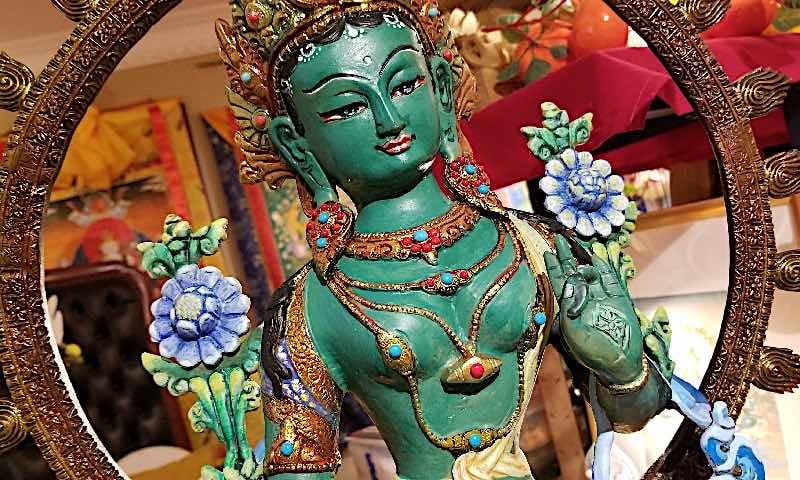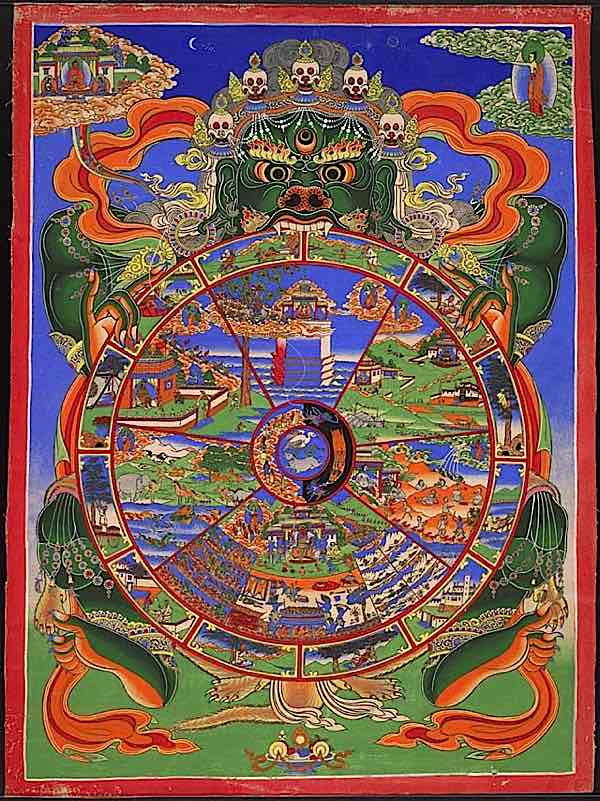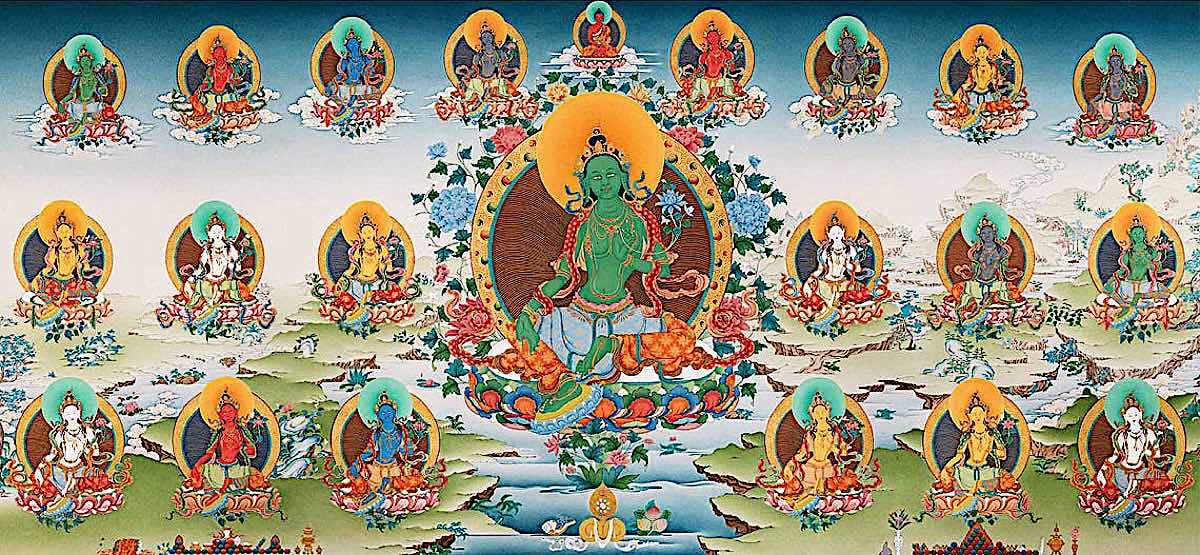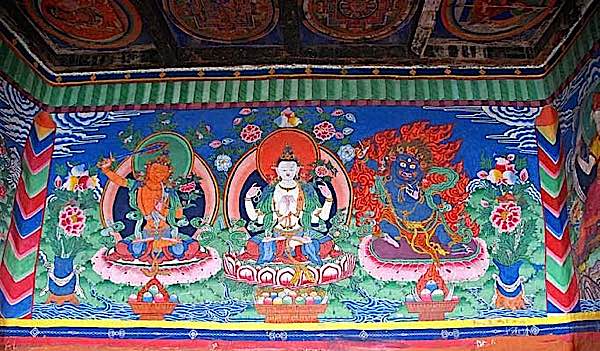Five Female Buddhas or Mothers: Their Roles as Prajnas or Enlightened Wisdom — Inseparable Co-Equals Rather Than Consorts
In Mahayana Buddhism, the Female Buddhas represent Perfect Wisdom and are indispensable. In Buddhism, the Female Buddhas sybmolize Perfect Wisdom while the Male Buddhas Represent Perfect Compassion in the Dhyani Buddha Cosmic Mandala. Both are co-equal partners as methods...

In Mahayana Buddhism, the Female Buddhas represent Perfect Wisdom and are indispensable. In Buddhism, the Female Buddhas sybmolize Perfect Wisdom while the Male Buddhas Represent Perfect Compassion in the Dhyani Buddha Cosmic Mandala. Both are co-equal partners as methods in Mahayana Buddhism. What is often misunderstood is the concept that even if you practice a single Buddha, for example, Amitabha, he is never separate from his Female Co-Equal Buddha Pandara. Or, if you practice Green Tara as a sole practice, she is never separate from her co-Equal Male Budddha Amoghasiddhi. These are forms, manifesting to help us according to our own preferences and needs, representing respectively wisdom and compassion.
 The Five Prajnas Wisdom Mothers are the co-equal female Buddhas of the five cosmic directions. In the Center is White Tara Ākāśadhātvīśvarī, in the North is Green Tara, in the East is Blue Locana, in the South is Yellow Mamaki and in the West is Red Pandaravasini. These beautiful cards are stunningly illustrated by Robert Place in his beautiful Buddha Tarot, available from Red Feature, or on Amazon>>* To read our interview with the insightful and amazing artist Robert Place, see this feature>>
The Five Prajnas Wisdom Mothers are the co-equal female Buddhas of the five cosmic directions. In the Center is White Tara Ākāśadhātvīśvarī, in the North is Green Tara, in the East is Blue Locana, in the South is Yellow Mamaki and in the West is Red Pandaravasini. These beautiful cards are stunningly illustrated by Robert Place in his beautiful Buddha Tarot, available from Red Feature, or on Amazon>>* To read our interview with the insightful and amazing artist Robert Place, see this feature>>
Redefining “Mr. and Mrs.” Buddhas?
In the Buddhist traditions of Tibet or Mahayana, the Victorian-English translation ‘consorts’ represents an unfortunate Victorian-English translation, reflecting an antiquated view of the Female Buddhas as “consort to the sovereign” context. Although the literal meaning is “partner”, from the 15th century on it came to be associated with the “spouse” of the reigning monarch (if a queen, then the husband; if a king, a wife). This is an incorrect association when it comes to the co-equals Prajna Buddhas (Female Buddhas.) The Female Buddhas are co-monarchs (to use that metaphor) not supportive spouses.
The symbolism of the Buddha couple when depicted in embrace is the joining of Wisdom and Compassion. (In more modest traditions, they may just appear to be hugging with clothes, including several Shingon paintings.) The metaphor is that Wisdom must always be joined with Compassion as a path to Enlightenment.
 The Five Buddha Families together as Co-Equal Buddhas. This beautiful tangkha by Andy Weber illustrates the mandala with Akshobya and Locana in the center switching places with Vairochana. This is because some of the tantras in the Gelug or Sarma traditions switch the positions, depending on the meditation. The majority of mandalas from older termas usually have Vairochana and White Tara in the center and Akshobhya Locana in the East. This is due to the association of Vairochana and White Tara as the co-heads of the Buddha Family, which is normally central. Beautiful Illustration from a Thangka and prints by Andy Webber, available on his website>>
The Five Buddha Families together as Co-Equal Buddhas. This beautiful tangkha by Andy Weber illustrates the mandala with Akshobya and Locana in the center switching places with Vairochana. This is because some of the tantras in the Gelug or Sarma traditions switch the positions, depending on the meditation. The majority of mandalas from older termas usually have Vairochana and White Tara in the center and Akshobhya Locana in the East. This is due to the association of Vairochana and White Tara as the co-heads of the Buddha Family, which is normally central. Beautiful Illustration from a Thangka and prints by Andy Webber, available on his website>>
Although the language is likely to “stick” due to existing translations of Sanskrit texts, the important take-away is that more “modern” interpretations, such as Prajna Buddha, Female Buddha, mother Buddha, or Wisdom Buddha.
A great example of this is Mother Tara — one of the most important enlightened Buddhas in Mahayana Buddhism. Her example shows us that the Wisdom or Prajna Female Buddhas are often better known than their Male co-equals.
 In Mahayana Buddhism, the Female Buddhas represent Perfect Wisdom and are indispensable. In Buddhism, the Female Buddhas sybmolize Perfect Wisdom while the Male Buddhas Represent Perfect Compassion. Both are co-equal partners as methods in Mahayana Buddhism. What is often misunderstood is the concept that even if you practice a single Buddha, for example, Amitabha, he is never separate from his Female Co-Equal Buddha Pandara. Or, if you practice Green Tara as a sole practice, she is never separate from her co-Equal Male Budddha Amoghasiddhi. These are forms, manifesting to help us according to our own preferences and needs. Photo of beautiful artwork in Bruno Letzia’s Siddartha Tarot Deck, which is a Vajrayana-inspired deck. Available from Amazon>>
In Mahayana Buddhism, the Female Buddhas represent Perfect Wisdom and are indispensable. In Buddhism, the Female Buddhas sybmolize Perfect Wisdom while the Male Buddhas Represent Perfect Compassion. Both are co-equal partners as methods in Mahayana Buddhism. What is often misunderstood is the concept that even if you practice a single Buddha, for example, Amitabha, he is never separate from his Female Co-Equal Buddha Pandara. Or, if you practice Green Tara as a sole practice, she is never separate from her co-Equal Male Budddha Amoghasiddhi. These are forms, manifesting to help us according to our own preferences and needs. Photo of beautiful artwork in Bruno Letzia’s Siddartha Tarot Deck, which is a Vajrayana-inspired deck. Available from Amazon>>
Co-equals, Not Mr. and Mrs. Consorts
Let’s start with some up-to-date language tweaks. Consort is a translation dating back to Victorian times, a highly archaic and non-relevant term meaning according to Oxford dictionary: “a wife, husband, or companion, in particular the spouse of a reigning monarch.” The problem with this term is that it’s symbolism is dated, implying both separation of two individuals, but also suggesting one is dependent on the other. Even if you add a modern-day understanding of equal husband and wife, the concept suffers from the notion of separateness. For this reason, most modern teachers prefer the term Female Buddhas or Mothers, rather than consort, when referring to Tara, Pandara, Locana, Mamaki, and Dharmadhatvishvari.
 Best known among the mothers, is Green Tara or White Tara, both of which are among the most popular practices in Vajrayana Buddhism. Green Tara, the Prajna Wisdom of the North, is especially popular, since she combines activity (north) with compassion and wisdom. With this combination, her results are always swift.
Best known among the mothers, is Green Tara or White Tara, both of which are among the most popular practices in Vajrayana Buddhism. Green Tara, the Prajna Wisdom of the North, is especially popular, since she combines activity (north) with compassion and wisdom. With this combination, her results are always swift.
In Mahayana and Vajrayana Buddhism, the concept of Male and Female Buddhas is not a sexual union or a husband-wife term. It is the union of Compassion and Wisdom — the two equal wings of the free-flying bird of Enlightenment. In the symbolism of Buddhism, Female Buddhas represent Wisdom and Male Buddhas represent Compassion. The union is not a sexual or physical relationship. It is the union of two co-equal aspects of the Enlightened Mind.
No Enlightenment without Prajna and Karuna
There is no Enlightenment, no freedom from Samsara, without embracing both Compassion and Wisdom, or Karuna and Prajna. They come together in the union of Perfection, the Perfection of Wisdom. The Male Buddha symbolizes Karuna or Compassion, and the Female Buddha represents Wisdom. They are always together, even if we visualize or practice them as solitary.
 The Five Mothers or Prajnas in their symbolic mandala positions: White Tara Ākāśadhātvīśvarī in the Center; Red Pandaravarsini in the West (top); Green Tara in the North (right); Blue Locana in the East (bottom) and Yellow Mamaki in the South (left). Photo of beautiful artwork in Bruno Letzia’s Siddartha Tarot Deck, which is a Vajrayana-inspired deck. Available from Llewelyn and on Amazon>>
The Five Mothers or Prajnas in their symbolic mandala positions: White Tara Ākāśadhātvīśvarī in the Center; Red Pandaravarsini in the West (top); Green Tara in the North (right); Blue Locana in the East (bottom) and Yellow Mamaki in the South (left). Photo of beautiful artwork in Bruno Letzia’s Siddartha Tarot Deck, which is a Vajrayana-inspired deck. Available from Llewelyn and on Amazon>>
The Symbolic Significance of the Five Female Buddhas within Buddhism
Every step towards the path of enlightenment is dressed in a dramatic display of profound symbolism, with each symbol dramatizing a tale of wisdom and discovery. The Five Female Buddhas, also known as the Five Prajnas, are a clear expression of this profound symbolism.
 Akasadhatvisvari White Tara. Image: Visible Mantra>>
Akasadhatvisvari White Tara. Image: Visible Mantra>>White Tara, Ākāśadhātvīśvarī, Dhatvishvari, Vajra Dhātvīśvarī is the wisdom consort of Vairochana, the Queen of Infinite Space; her emblem, the Wheel of Dharma, and Her white color and the sprawling open sky, symbolize boundless wisdom as vast and infinite as the cosmos. She has many forms, including White Tara and Buddha Dakini.
 Green Tara. Image, Visible Mantra>>
Green Tara. Image, Visible Mantra>>
Perhaps best known is Green Tārā, designated the wisdom counterpart of Amoghasiddhi, which is linked to the element of air. Her symbol is the double vajra, Her color green, representing windy activity. She embodies the winds of compassion and actions that swiftly act to relieve suffering, symbolized by the eight great fears (from the Sutra Tara Who Protects from Eight Fears.
 Locana. Image Visible Mantra>>
Locana. Image Visible Mantra>>
Locanā, counterpart to Akshobya, is associated with the blue color and the symbol of a vajra or thunderbolt, embodying depths of understanding as fathomless as the deep blue sea, and the ability to transmute anger into mirror-like wisdom. She also emanates as Black Tara, who also carries a vajra, and as Vajra Dakini.
Māmakī is the wisdom partner of Ratnasambhava, sovereign of the element earth. Her symbol is the jewel and Her yellow-golden color, represents the richness of the earth. This emphasizes her mission of equanimity, nurturing the growth of wisdom through richness and diversity, and especially generosity. She is often associated with Yellow Tara and Ratna Dakini.
 Pandaravashini. Image Visible Mantra>>
Pandaravashini. Image Visible Mantra>>
Paṇḍāravāsinī, the wisdom Female Buddha of Amitabha’s Family, rules the element of fire, and is shining red, like all the magnetizing deities, such as Vajrayogini, Vajravarahi and Kurukulla. Her emblem, the lotus, signifies purification and transformation—inspiring us to transform our worldly desires into wisdom.
Summarizing the Energies of the Five Female Buddhas and Families
| Vairocana Family | Center | White | Ignorance | All-Accomplishing Wisdom | Vairochana | Ākāśadhātvīśvarī or White Tara | Wheel | Lion | Samantabhadra |
| Akshobhya Family | East | Blue | Anger | Mirror-like Wisdom | Akshobya | Locanā | Vajra | Elephant | Vajrapani |
| Ratnasambhava Family | South | Yellow | Pride | Equality Wisdom | Ratnasambhava | Māmakī | Jewel | Horse | Ratnapani |
| Amitabha Family | West | Red | Attachment | Discriminating Wisdom | Amitabha | Paṇḍāravāsinī | Lotus | Peacock Dragon | Avalokiteshvara |
| Amoghasiddhi Family | North | Green | Jealousy | Action-Accomplishing Wisdom | Amoghasiddhi | Tārā | Double Vajra | Garuda | Visvapani |
Ultimately, practicing any one of these as your Yidam or meditational practice is complete, as long as you understand they are always in union, even if you visualize their solitary form. Usually, we choose our Yidam or practice based on what we are personally working on — or our teacher advises us to work on.
 Many of Buddha’s core teachings are represented sybolically in the iconic Tibetan Wheel of Life tangkha, including the Poisons which keep us trapped in Samsara. The remedies for the the poisons are the Five Wisdoms of the Five Buddha Families.
Many of Buddha’s core teachings are represented sybolically in the iconic Tibetan Wheel of Life tangkha, including the Poisons which keep us trapped in Samsara. The remedies for the the poisons are the Five Wisdoms of the Five Buddha Families.
Poisons remedied
For Anger, we might practice Locana or Akshobya (either or both), who exemplify Mirror Like Wisdom to overcome anger. If we focus on Locana, we are focusing on the wisdom aspect of overcoming anger, we might on Locana; if we are connecting with the compassion aspect, we might focus more on Akshobya, but both are complete Yidams, incorporating both. For Jealousy — one of the most common of poisons today (since many of the other poisons, such as anger and pride arise from jealousy) — we might choose to practice Tara or Amoghasiddhi, who exemplify action-accomplishing wisdom. Ultimately, all Dharmas tend to have an aspect of activity and karma, so Tara is usually with us regardless of our Yidam. If we suffer from immense Pride, we would focus on Equality Wisdom and will focus on Mamaki and Ratnasambhava. If — as most of us do — we suffer from Ignorance, without comprehension of reality as it truly is, we might focus on White Tara (Ākāśadhātvīśvarī) or Vairochana. If we suffer from Attachment and Craving, the recommended practice might be Pandaravasini or Amitabha. Most of our common issues today arise from attachment, making Amitabhaa and Pandaravasini extremely popular. The Five Prajnas of the Dhyani Buddha mandala are beautifully represented in Robert Place’s “mandala of cards” as he calls it in the Buddha Tarot. In the center is White Tara. Notice how Robert Place color-codes the White Tara card with the mandala colors (red on top, green on the right, blue on the bottom and yellow on the left. In this photos we placed the four other Mothers around according to this color scheme to complete the Dhyani Buddha mandala with Pandara Vashini on the top (west), Green Tara on the right (north), Locana on the bottom (east) and Yellow Mamaki on the left (south.) This is one of the ingenious aspects of his Mandala system in the Buddha Tarot. Note also how Robert places the sacred animal of each family and the symbols on the throne of each (for example the horse and jewel with Mamaki, and the Garuda and Double Vajra for Green Tara. Buddha Tarot available on Amazon>>
The Five Prajnas of the Dhyani Buddha mandala are beautifully represented in Robert Place’s “mandala of cards” as he calls it in the Buddha Tarot. In the center is White Tara. Notice how Robert Place color-codes the White Tara card with the mandala colors (red on top, green on the right, blue on the bottom and yellow on the left. In this photos we placed the four other Mothers around according to this color scheme to complete the Dhyani Buddha mandala with Pandara Vashini on the top (west), Green Tara on the right (north), Locana on the bottom (east) and Yellow Mamaki on the left (south.) This is one of the ingenious aspects of his Mandala system in the Buddha Tarot. Note also how Robert places the sacred animal of each family and the symbols on the throne of each (for example the horse and jewel with Mamaki, and the Garuda and Double Vajra for Green Tara. Buddha Tarot available on Amazon>>
Who are the Five Female Buddhas and What is Their Significance?
The Five Female Buddhas, also referred to as the “Five Prajnas,” play a pivotal role in Buddhist teachings and are believed to bring balance and completeness to the divine process of enlightenment. The term “prajna” refers to the Sanskrit word for wisdom, highlighting their profound symbolism as embodiments of certain transcendent wisdom aspects. Each of these female Buddhas is associated with a specific Dhayani Buddha, reflecting the profound interconnectedness within the Buddhist cosmos.
“The Five Female Buddhas, embody aspects of enlightenment, bearers of wisdom, bringers of balance, and symbols of divine feminine energy.”
 White Tara Ākāśadhātvīśvarī is the center of the Dhyani Mandala, Prajna of the Buddha Family. Notice how Robert Place (the illustrator) cleverly surrounds her with the four other family mandala colors to indicate they are part of one cosmic mandala. White Tara is also an very popular stand-alone Yidam practice, and is famous for her long-life practices, health nd healing and auspcious activities. Buddha Tarot available on Amazon>>
White Tara Ākāśadhātvīśvarī is the center of the Dhyani Mandala, Prajna of the Buddha Family. Notice how Robert Place (the illustrator) cleverly surrounds her with the four other family mandala colors to indicate they are part of one cosmic mandala. White Tara is also an very popular stand-alone Yidam practice, and is famous for her long-life practices, health nd healing and auspcious activities. Buddha Tarot available on Amazon>>Ākāśadhātvīśvarī or White Tara: Wisdom Female Buddha with White Dhayani Buddha Vairochana
Ākāśadhātvīśvarī, (White Tara, Dhatvishvari, Vajra Dhātvīśvarī) the wisdom consort of Vairochana, represents the space element. Her name means “Sovereign Lady of the Sphere of Infinite Space” and she holds two Lotuses, one, over her left shoulder with a vajra-bell and the other, over her right shoulder, with a Dharmachakra Wheel of Dharma. She wields the power of the infinite, embodying the interconnectedness of all phenomena.
 Prajna Buddha Akasadhatvisvari White Tara with Compassion Buddha Vairochana. In most mandalas they are the in center, although in specialized practices, they move to the East. Illustration from a Thangka and prints by Andy Webber, available on his website>>
Prajna Buddha Akasadhatvisvari White Tara with Compassion Buddha Vairochana. In most mandalas they are the in center, although in specialized practices, they move to the East. Illustration from a Thangka and prints by Andy Webber, available on his website>>
Vairochana and Akasadhatvisvari together the central figures among the five Buddhas famlies, exemplifies the crystalline and original purity of the mind, making Ākāśadhātvīśvarī — none other than an emanation of White Tara — an indispensable and complementary Wisdom co-equal to his enlightened qualities of Compassion.
 Akasadhatvisvari’s mantra as the Prajna Mother in Siddham script. NOTE: As White Tara she has many other mantras, due to the vast popularity of her practice. Script from Visiblemantra.org>>
Akasadhatvisvari’s mantra as the Prajna Mother in Siddham script. NOTE: As White Tara she has many other mantras, due to the vast popularity of her practice. Script from Visiblemantra.org>>
Ākāśadhātvīśvarī’s mantra and seed syllable
The seed syllable of Akasadhatvisvari is aṃ and her powerful mantra is,
oṃ sarva buddha jñāna aṃ svāhā
 Am seed syllable.
Am seed syllable.
Mantras, in essence, are more than mere words. They’re potent sound vibrations carrying specific spiritual energy that transcends our conventional understanding of language. When uttered with reverence and faith, this mantra brings a sense of tranquility, intuitive wisdom, and spiritual clarity in the practitioner’s mind.
 Akasadhatvisvari’s mantra in Tibetan script.
Akasadhatvisvari’s mantra in Tibetan script.
Her seed syllable, “aṃ”. Seed syllables in Buddhism aren’t arbitrary. They’re the quintessence of a deity’s wisdom and the very essence of their being. “aṃ”, belonging to Ākāśadhātvīśvarī, signifies the transformative power of spiritual realization, cutting through delusion and connecting us directly to her infinite wisdom.
“Just as a mighty river flows unimpeded, the chanting of Ākāśadhātvīśvarī’s mantra ensures that the practitioner’s mind flows unimpeded towards the great sea of enlightenment.”
 White Tara in Bruno Letzia’s beautifully Siddartha Tarot. Photo of beautiful artwork in Bruno Letzia’s Siddartha Tarot Deck, which is a Vajrayana-inspired deck. Available from Llewelyn and on Amazon>>
White Tara in Bruno Letzia’s beautifully Siddartha Tarot. Photo of beautiful artwork in Bruno Letzia’s Siddartha Tarot Deck, which is a Vajrayana-inspired deck. Available from Llewelyn and on Amazon>>The mantra and seed syllable of Ākāśadhātvīśvarī provide an unfailing wisdom light on the path, perpetually guiding towards the ultimate reality.
Resources
Arya Supreme White Tara on Buddha Weekly Special Feature>> White Tara Guided Visualization Video>> Learn more about Akasadhatvisvari on Visible Mantra>> NOTE: About incorrect pronunciations and transcriptions of Ākāśadhātvīśvarī. From Visible Mantra: “There are a couple of incorrect variations on the spelling of the name Ākāśadhātvīśvarī. One sees, for instance, the spelling Ākāśadhātīśvarī which may be down to Lama Govinda as he uses that spelling in his Foundations of Tibetan Mysticism. One may also see Ākāśadhāteśvarī and this may be an attempt to model it on the name Avalokiteśvara but it is erroneous. Ākāśadhātvīśvarī a compound of ākāśa + dhātu + īśvarī. When combining the last two words in a compound the Sanskrit sandhi rules dictate that u + ī combines give vī. (according to my Sanskrit guru)” Green Tara. Tara is an action-heroine Buddha, the activity of all the Buddhas since she rules the Karma (activity) family. She has countless poses, standing, half sitting, riding an elephant, flying on a garuda or a dragon, and the classic seated in a half-lotus with foot thrust out. In Bruno Letzia’s card, she is in the standing pose. Photo of beautiful artwork in Bruno Letzia’s Siddartha Tarot Deck, which is a Vajrayana-inspired deck. Available from Llewelyn and on Amazon>>
Green Tara. Tara is an action-heroine Buddha, the activity of all the Buddhas since she rules the Karma (activity) family. She has countless poses, standing, half sitting, riding an elephant, flying on a garuda or a dragon, and the classic seated in a half-lotus with foot thrust out. In Bruno Letzia’s card, she is in the standing pose. Photo of beautiful artwork in Bruno Letzia’s Siddartha Tarot Deck, which is a Vajrayana-inspired deck. Available from Llewelyn and on Amazon>>
Tārā: Wisdom Consort of Green Dhayani Buddha Amoghasiddhi
Often referred to as the “Tara, Mother of All Buddhas,” Tārā embodies the wisdom of perfect action, making her the wisdom consort to the fearless Amoghasiddhi. Tārā’s symbolism as a compassionate savior resonates with Amoghasiddhi’s commitment to remove fear and lead every individual along the path of enlightenment. Her well-known “Tara posture” is one foot thrust forward — ready to jump to our aid — and the other tucked in meditative equipoise, suiting her role as the Wisdom Buddha.
In Buddhism, where karma is the “creator” of Samsara — our negative and positive activities in our lives determine our suffering — it is the wisdom of compassionate activity, represented by Tara, which is the Wisdom Mother of the Karma Family, who is our ultimate salvation and Buddhahood. Wisdom without activity is only theoretical. Compassion without activity is only wishful thinking. It is the activity of both that helps us progress towards ultimate realizations.
She is called the Mother of All the Buddhas because the compassionate wisdom activites are the path to enlightenment. Philosophy alone is not enough. Our conduct, merits, and virtues in this life and previous lives are critical to progress towards realizations and, ultimately, enlightenment. Tara is the wisdom of activity and the activity of wisdom. Through her activities, Buddhas achieve realizations. For these reasons and others, she is called the Mother of All the Buddhas.
 Tam syllable in Siddhim script.
Tam syllable in Siddhim script.
Tara’s mantra and seed syllable
The seed syllable of Tara is tāṃ and her powerful mantra is
 Tara mantra in Siddhim script.
Tara mantra in Siddhim script.
oṃ tāre tuttāre ture svāhā
 Mother Green Tara is the Prajna Buddha of the North Karma family. Notice how Robert Place brilliantly borders the card with the throne of Garudas, the sacred animal of the north and the double vajras, a symbol of the Northern Karma family. Buddha Tarot available on Amazon>>
Mother Green Tara is the Prajna Buddha of the North Karma family. Notice how Robert Place brilliantly borders the card with the throne of Garudas, the sacred animal of the north and the double vajras, a symbol of the Northern Karma family. Buddha Tarot available on Amazon>>
Tara’s activity is so pervasive, that even when she is not your main Yidam, she is still the Buddha typically called on for help when in danger, with her well-known mantra, or her equally popular 21 Praises to Tara, chanted in Sanskrit, Tibetan or translated to English and other languages. Tibetan Buddhists, even those with other practices, often start their day with the 21 Praises to Tara, which honors 21 of her forms.
 Tara mantra in Tibetan Script.
Tara mantra in Tibetan Script.
Identical to her Compassion Buddha Partner Amoghasiddhi, she is green, her symbol is the double vajra, Her “son” or Bodhisattva is Visvapani, and her helper is King Garuda — the Lord of Action and the five activities.
 Green Tara Prajna Wisdom Buddha of the North with Compassion Male Buddha Amoghasiddhi. They are symbolically shown in union to express that Wisdom Activity and Compassion Activity are always in union. They are always in the North of Mandala, representing windy activity and air. Illustration from a Thangka and prints by Andy Webber, available on his website>>
Green Tara Prajna Wisdom Buddha of the North with Compassion Male Buddha Amoghasiddhi. They are symbolically shown in union to express that Wisdom Activity and Compassion Activity are always in union. They are always in the North of Mandala, representing windy activity and air. Illustration from a Thangka and prints by Andy Webber, available on his website>>
Due to her association with activity and karma, Tara emanates in more forms than any other Buddha. She is, in essence, the Prajna activity of every Buddha, and she emanates a form for any danger, fear, poison or enemy. In addition to the 21 forms of Tara, her other praises is the Praise to the 1008 Names of Tara. For this reason, she is often called Limitless Tara.
Her most famous forms include:
Green Tara — savior heroine called on by millions around the world. For a feature on Green Tara, see>> White Tara — who also emanates as the Prajna of Vairochana. For a feature on White Tara, see>> Kurukulla Red Tara — a form of Tara who emanates from the Padma family of Amitabha — her spiritual teacher, who focuses on magnetizing activities. For a feature on Kurukulla, see>> Black or Blue Tara — a form of Tara “Who destroys all enemies”, who emanates to the Vajra Family. Note “destroying enemies means the “poisons”; she does not literally destroy any being. Another form of Black Tara is Ekajati. For a feature on Black Tara, see>> Parnashavari, Tara Dressed in Leaves, Tara the Healer, who emanates to Ratnasambhava’s Jewel Family, and is very powerful for healing activities. For a feature on Parnashavari, see>> Vasudhara Tara, whose name means “stream of gems” is, essentially, the blessings and bounty of mother Earth, and the Tara who can bring prosperity and auspicious circumstances. She is also associated with Vasundhara, who is an actual manifestation of Mother Earth, and who was the “witness to Buddha’s merits” under the Bodhi Tree. See this feature>> Sitatapatra, the “undefeatable one”, the form of White Tara with 1000 arms who is the “ultimate” protective goddess. For a feature on Sitatapatra, see>>Atributes and Symbols of Green Tara
Colour: green Element: wind, air, chi, prana Wisdom: Action-Accomplishing Wisdom Compassion Buddha Partner: Amoghasiddhi Family: Karma Bodhisattva: Visvapani Dakini: Karma Dakini Pure Land: Tuquoise Pureland Yurlod Kurpa Direction: North Emblem: Double Vajra (Visvavajra) Sacred Animal: Garuda Mudra: Seed-syllable: Tam Poison She Specializes in: Jealousy Magical function: ALL activities Paramita:right actions & vows Tara manifests in countless forms, the most famous of which are the 21 Taras. This painting of 21 Taras is according to the Nyingma Terma tradition, courtesy (and with permission) of VajrayanaPrint on Etsy. This is a rare horizontal format of the 21 Taras. (Most Thangkas are vertical) making this very special and unique. Contact VajrayanaPrint on Etsy for information>>
Tara manifests in countless forms, the most famous of which are the 21 Taras. This painting of 21 Taras is according to the Nyingma Terma tradition, courtesy (and with permission) of VajrayanaPrint on Etsy. This is a rare horizontal format of the 21 Taras. (Most Thangkas are vertical) making this very special and unique. Contact VajrayanaPrint on Etsy for information>>
Resources
Our Special Section with dozens of features on Tara on Buddha Weekly>> Tara’s Eight Great Laughters Transform the Eight Great Fears feature>> Tara’s Great Dharani and Sutra>> Tara the Windy Liberator, the Activity Heroine in Buddhism>> Aspire to Tara’s Turquoise Pureland>> Mama Buddha Tara: Compassion in Action, True Stories of Tara Rescues>> Locana, the blue Prajna Mother of the East, Co-Equal Buddha with Akshobya. This beautiful card is illustrated by Bruno Letzia in his Tarot deck Siddartha Tarot. Photo of beautiful artwork in Bruno Letzia’s Siddartha Tarot Deck, which is a Vajrayana-inspired deck. Available from Llewelyn and on Amazon>>
Locana, the blue Prajna Mother of the East, Co-Equal Buddha with Akshobya. This beautiful card is illustrated by Bruno Letzia in his Tarot deck Siddartha Tarot. Photo of beautiful artwork in Bruno Letzia’s Siddartha Tarot Deck, which is a Vajrayana-inspired deck. Available from Llewelyn and on Amazon>>
Locanā: Wisdom Female Buddha with Blue Dhayani Buddha Akshobya
Equivalent to the mirror-like wisdom, Locanā is the wisdom consort of Akshobya, who is marked by his steadfast and unwavering character.
Like Compassion Buddha Akshobya she is blue, like space and the cosmos, or like the deepest blue ocean. By being the embodiment of supreme patience, Locanā supposedly provides the soothing energy that tames anger and aggression, further emphasizing her critical role in the moral and spiritual development of Buddhist practitioners.
Like her Partner Akshobya, Her symbols include the Vajra and the Elephant, and her “Son”, the Bodhisattva of Her Family is powerful Vajrapani. She helps bring good fortune and auspiciousness.
 Locana Prajna Mother Buddha with Abshokya Buddha in the East of most mandalas. In some specialized practices they are in the center and White Tara and Vairochana move to the east (in that case.) Illustration from a Thangka and prints by Andy Webber, available on his website>>
Locana Prajna Mother Buddha with Abshokya Buddha in the East of most mandalas. In some specialized practices they are in the center and White Tara and Vairochana move to the east (in that case.) Illustration from a Thangka and prints by Andy Webber, available on his website>>
Locana’s mantra and seed syllable
 Lom seed syllable in Siddhim script
Lom seed syllable in Siddhim script
The seed syllable of Locana is loṃ and her powerful mantra is:
oṃ vajra locane loṃ svāhā
 Locana mantra in Siddhim script.
Locana mantra in Siddhim script.
The seed syllable of Locana, loṃ, a single phonetic rumble that encapsulates the grandeur of her essence, symbolizes the very nature of this wisdom deity. This syllable manifests her inherent wisdom and power as a Dharmakaya form, radiating an aura of spiritual energy potent enough to awaken the Buddha within us all.
 Locana Prajna Buddha of the Vajra Buddha family. Buddha Tarot available on Amazon>>
Locana Prajna Buddha of the Vajra Buddha family. Buddha Tarot available on Amazon>>
Working on Overcoming Anger? Steadfast Locana May Help Cool Your Anger — and the Anger of Others
Contemplating Locanā’s mantra and seed syllable connects us to the mirror-like wisdom of Locana. Like her Compassion Male Buddha Partner Akshobya, Her symbols include the Vajra and the Elephant, and her “Son”, the Bodhisattva of Her Family is mighty Vajrapani.
 Locana mantra in Tibetan Script.
Locana mantra in Tibetan Script.
Atributes and Symbols of Locana
Colour: blue Element: water Wisdom: Mirror-Like Compassion Buddha Partner: Akshobya Family: Vajra Bodhisattva: Vajrapani Dakini: Vajra Dakini Pure Land: Direction: East (sometimes center in some lineages for special practices) Emblem: Vajra Sacred Animal: Elephant Mudra: Seed-syllable: Loṃ Poison She Specializes in: Anger Realm: hell Magical function: wrathful or supressing activities Paramita: wisdom & knowledge Precept: Not stealing Mamaki, the Prajna Wisdom Mother of the Southern Jewel (Ratna) Family. Photo of beautiful artwork in Bruno Letzia’s Siddartha Tarot Deck, which is a Vajrayana-inspired deck. Available from Llewelyn and on Amazon>>
Mamaki, the Prajna Wisdom Mother of the Southern Jewel (Ratna) Family. Photo of beautiful artwork in Bruno Letzia’s Siddartha Tarot Deck, which is a Vajrayana-inspired deck. Available from Llewelyn and on Amazon>>
Māmakī: Wisdom Female Buddha with Yellow Dhayani Buddha Ratnasambhava
Māmakī forms an integral part of the teachings associated with Ratnasambhava—specifically, the princely wisdom that transforms pride into generosity and humility. As a figure symbolic of equanimity, she exercises an influential role in promoting the virtues of tolerance, generosity, and spiritual wealth among her followers.
Like her Compassion Male Buddha Partner Ratnasambhava, Her symbols include the Wish-Granting Jewel and the Horse, and her “Son”, the Bodhisattva of Her Family is auspicious Ratnapani. She helps bring good fortune and auspiciousness.
Mamaki Mantra
The seed syllable of Mamaki is Mam
 Mam seed syllable Siddhim Script.
Mam seed syllable Siddhim Script.and Her mantra is:
 Mamaki’s mantra in Siddhim script.
Mamaki’s mantra in Siddhim script.
oṃ ratne suratne māṃ svāhā
 Mamaki, the Prajna Wisdom Mother of the South. Buddha Tarot available on Amazon>>
Mamaki, the Prajna Wisdom Mother of the South. Buddha Tarot available on Amazon>>
Atributes and Symbols of Mamaki
Colour: yellow Element: earth Wisdom: Equality Compassion Buddha Partner: Ratnasambhava Family: ratna-jewel Bodhisattva: Ratnapani Dakini: Ratna Dakini Pure Land: Shrimat Direction: south Time of day: noon Emblem: jewel Sacred Animal: Horse and camel Mudra: supreme giving Seed-syllable: MAM Poison She Specializes in: Pride Realm: hungry ghost Magical function: increasing Aggregate: feeling Paramita: Generosity and PowerWorking on Overcoming Pride? Auspicious Māmakī: Wisdom Prajna of Yellow Dhayani Buddha Ratnasambhava
Let’s take the example of Mamaki and Ratnsambhava. Immersed in the sea of samsara, in our lives we all fall prey to the destructive emotion of pride. It creeds its way into our ego, wrapping around our thoughts and actions, making us believe our superiority over others. Isn’t it ironic that this very pride, this sense of inflated self, only serves to distract us from the path of true enlightenment?
The wisdom consort factor in Buddhism provides a profound antidote to this disruptive emotion, ‘Pride’. Enter Mamaki, the wisdom consort of the Yellow Dhyani Buddha, Ratnasambhava. Her presence brings with her a unique energy, channeling the essence of Equality Wisdom – a distinct quality associated with Buddha Ratnasambhava. This wisdom points towards the understanding that all beings and phenomena share the same nature of emptiness, thus making no room for the existence of pride.
Mamaki (Māmākī): An embodiment of pristine awareness, Mamaki is often depicted radiating yellow light, the same as Ratnasambhava. Her primary purpose is to help inspire wisdom feelings of equality, thereby confronting and overcoming the destructive emotion of pride. She is often seen holding a vajra and a bell, symbols of wisdom and the dissolution of the ego. Ratnasambhava: The Yellow Dhyani Buddha Ratnasambhava sits resplendently in the South, embodying the Wisdom of Equality. He works in tandem with his wisdom consort Mamaki, aiming to purge all forms of pride and ego. His compassion helps in transforming the poison of ego inflation into the wisdom that recognizes all beings as equal. For this reason, he is associated with “wealth” and generosity practices such as Yellow DzambalaSo, how does embracing the energies of Mamaki and Ratnasambhava help mitigate our wayward pride? While on the surface, it may seem like an elaborate tale of mythical beings and their powers, at the core, it is a call to self-reflect, to introspect. To realize that our inflated ego, our pride, only takes us farther from the truth of our existence, the truth of equality within all.
“Pride divides us, while humility brings us together.” – are we not reminiscent of this timeless wisdom uttered by several spiritual leaders?
 Mamaki with Ratnasambhava in the south of the mandala. Illustration from a Thangka and prints by Andy Webber, available on his website>>
Mamaki with Ratnasambhava in the south of the mandala. Illustration from a Thangka and prints by Andy Webber, available on his website>>The path of Buddhism isn’t about revering divine figures — or even understanding them academically. Each symbol and sadhana and practice is a dramatic play — like a movie or stage play — designed to evoke a deeper level of involvement in the meditation. It is a call to action, an invitation to apply these teachings in day-to-day life as a practice, a meditation, and a path of compassionate wisdom activities.
 Pandara Vasini is the Prajna Wisdom Mother of the West with her Compassion Male Buddha Amitabha. They preside over the famous Sukhavati Pureland. Photo of beautiful artwork in Bruno Letzia’s Siddartha Tarot Deck, which is a Vajrayana-inspired deck. Available from Llewelyn and on Amazon>>
Pandara Vasini is the Prajna Wisdom Mother of the West with her Compassion Male Buddha Amitabha. They preside over the famous Sukhavati Pureland. Photo of beautiful artwork in Bruno Letzia’s Siddartha Tarot Deck, which is a Vajrayana-inspired deck. Available from Llewelyn and on Amazon>>
Paṇḍāravāsinī or Pandara: Wisdom Female Buddha with Red Dhayani Buddha Amitabha
Paṇḍāravāsinī or Pandara, as the wisdom consort of Amitabha, plays the role of the embodiment of discernment—discriminating between the wholesome and unwholesome, beneficial and harmful. By teaching the power of discerning wisdom, she is regarded as a guide for navigating the path towards enlightenment, ensuring that practitioners remain steadfast in their journey.
Like her Co-Equal Compassion Buddha Amitabha, Her color is red, and Kurukulle Red Tara and Vajrayogini and Padma Dakini can be considered emanations of Her. Her symbol is the Lotus (padma) and her sacred animals are the Peacock and Dragon. Her “son” or Bodhisattva is, of course, Avalokiteshvara (Chenrezig, Guan Yin).
 Pandara Vasini with Amitabha Buddha in the West. Illustration from a Thangka and prints by Andy Webber, available on his website>>
Pandara Vasini with Amitabha Buddha in the West. Illustration from a Thangka and prints by Andy Webber, available on his website>>
Pandaravasini’s mantra and seed syllable
The seed syllable of Pandaravasini is paṃ and her powerful mantra is:

oṃ padma devi puṣpa devi paṃ svāhā
 Pam syllable in Siddhim
Pam syllable in Siddhim
The seed syllable of Pandaravasini, pam, a single phonetic rumble that encapsulates the grandeur of her essence, symbolizes the very nature of this wisdom deity. Pam is also the seed syllable meditators generate when visualizing the sacred Lotus.
 Pandaravasini mantra in Tibetan Script.
Pandaravasini mantra in Tibetan Script.
Atributes and Symbols of Pandaravasini
Colour: red Element: fire Wisdom: Discriminating Awareness Compassion Buddha Partner: Amitabha Family: Lotus or Padma Bodhisattva: Avalokiteshvara Dakini: Padma Dakini Pure Land: Sukhavati (Western Pureland) Direction: west Emblem: Lotus Sacred Animal: Peacock, Pheonix, Dragon Mudra: supreme giving Seed-syllable: PAM Poison She Specializes in: Attachment Realm: human Magical function: magnetizing Aggregate: perception Paramita: effort and Upaya Precept: Telling on the TruthReleasing the Archaic Word Consort
Releasing the use of the archaic word “consort” is a good beginning to a modern understanding of Female Buddhas. They are not only co-equal — they are half of the total. Amoghasiddhi is incomplete without Tara — and vice versa. This doesn’t mean that if we practice Tara, we’re forgetting Amoghasiddhi and, therefore, do not have complete practice. Her practice already incorporates Wisdom and Compassion, even if it is not embodied or visualized as Amoghasiddhi. They are, in essence, one being.
It is likewise the same with:
Amitabha and Prajna co-equal Wisdom Female Buddha Pandara Akshobya and Prajna co-equal Wisdom Female Buddha Locana Ratnasambhava and Prajna co-equal Wisdom Female Buddha Mamaki Vairochana and Prajna co-equal Wisdom Female Buddha White Tara or Dharmadhatvishvari or AkasadhatvisvariIf your Yidam is Tara, you already have Amoghasiddhi incorporated in your practice. If your Yidam is Amitabha, you already have Pandara in your practice. If you practice White Tara, you arleady practice Vairochana. There is never any separation, even if you only visualize one or the other. The choice of a Yidam is one of both personal need and choice, and guidance of our teachers.
Buddhas in Embrace
The symbolism of the Father and Mother embrace appears, at first to be sexual, but is intended in the context of Buddhist symbolism to indicate that Wisdom (Mother) and Compassion (Father), are inseparale. In Tibetan Buddhism, this takes the form of yabyum, or joined father and mother. In Japan, the father an mother’s are depicted “hugging” rather than in the more immodest union. Either way, this symbolism has nothing to do with sexuality, and everything to do with symbolism. In Buddhist art, symbolism such as color and pose are merely metaphors and symbols. We don’t expect Tara is always sitting with one leg outstretched, never moving. This simply depicts the idea of her “ready to jump to our aid.” In the same way, the green color of Tara depicts “windy activity. And the embrace of Father and Mother connotes the inseparable union of wisdom and compassion.
In this way, even if we practice Tara as a main Yidam, she is always with her co-equal Compassionate Buddha Amoghasiddhi. This is because she embodies both Wisdom and Compassion.
Sons and Daughters
Similarly, we also hear the terms “sons” and “daughters” of the Buddhas. Does this mean Amitabha and Pandara had a child? The children are the Bodhisattvas. The “daughters” can also manifest as Wisdom Dakinis. Each Buddha “family” has a Buddha, a Female Buddha and a Bodhisattva (often many), a Wisdom Dakini, and a Sacred Animal. This does not mean literal progeny. In spiritual terms, it means either emanation or disciple. In this metaphor, Amitabha, for example, is the Father of the Padma or Lotus Family, Pandaravasini (Pandara Vasini) is the Mother, and Avalokiteshvara is the Son (Bodhisattva). They all represent different aspects of the same Enlightened Being: Amitabha is Compassion, Pandara is Wisdom, and Avalokiteshvara is the Heroic Activity of both Wisdom and Compassion. In essence, all aspects of One.
The greatest wisdom is seeing through appearances.
– Atisha
 The most famous of the “sons” or Bodhisattvas are the Three Great Ones. In this temple mural, on the left is Manjushri , in the center is Avalokiteshvara (son of the Lotus family) and Vajrapani (son of the Vajra family.)
The most famous of the “sons” or Bodhisattvas are the Three Great Ones. In this temple mural, on the left is Manjushri , in the center is Avalokiteshvara (son of the Lotus family) and Vajrapani (son of the Vajra family.)
Education Links and References
To provide a comprehensive and educational answer, here is a list of sources that can offer more information about the five female Buddhas or Five Prajnas and their roles as prajnas or wisdom consorts. These sources can help you delve deeper into the subject and understand the meaning behind the concept of consorts in Buddhism. Here are some useful links:
The Buddhist Centre – Female Buddhas: This article explores the significance of the five female Buddhas and their roles as wisdom consorts. It provides a detailed analysis of each female Buddha and their association with the five Dhayani Buddhas. You can find it here>> Tricycle – The Five Wisdom Dakinis: This resource offers an in-depth exploration of the five female Buddhas, known as wisdom dakinis in Tibetan Buddhism. It discusses their symbolism, attributes, and the transformative power they represent. You can access it here>> Rigpa Wiki – The Five Female Buddhas: Rigpa Wiki provides a comprehensive overview of the five female Buddhas, including their names, associated colors, and their corresponding Dhayani Buddhas. It also delves into the concept of consorts and their significance. You can read more at>> Buddhanet – Female Buddhas: This webpage provides a concise yet informative overview of the five female Buddhas and their roles as wisdom consorts. It highlights their unique qualities and the importance of their presence in Buddhist iconography. You can visit the page here>> Himalayan Art Resources – Female Buddhas: This online gallery showcases various artistic representations of the five female Buddhas. It offers visual references that can enhance your understanding of their symbolism and iconography. You can explore the gallery, information and images here>>. Visible Mantra — source of mantras and seed syllables. You can visit pages:I hope these resources will assist you in gaining a deeper understanding of the five female Buddhas and their roles as prajnas or wisdom consorts. They provide valuable insights into the rich symbolism and meaning behind these revered figures in Buddhism.
* Amazon links are affiliate links. Your price will remain the same if you buy, but Buddha Weekly may receive a small commission, which helps support our mission.

 Tekef
Tekef 





























![Local SEO: How To Make More Customers Click, Choose & Walk Through Your Doors [Webinar] via @sejournal, @hethr_campbell](https://www.searchenginejournal.com/wp-content/uploads/2025/04/featured-596.png)

_1.jpg)